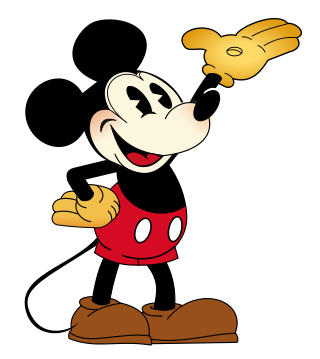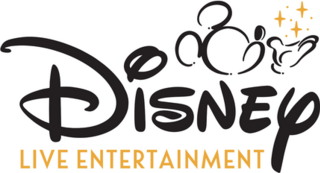Related Research Articles

Mickey Mouse is an American cartoon character co-created in 1928 by Walt Disney and Ub Iwerks. The longtime icon and mascot of the Walt Disney Company, Mickey is an anthropomorphic mouse who typically wears red shorts, large shoes, and white gloves. He is often depicted alongside his girlfriend Minnie Mouse, his pet dog Pluto, his friends Donald Duck and Goofy and his nemesis Pete among others.

Walter Elias Disney was an American animator, film producer, voice actor, and entrepreneur. A pioneer of the American animation industry, he introduced several developments in the production of cartoons. As a film producer, he holds the record for most Academy Awards earned (22) and nominations (59) by an individual. He was presented with two Golden Globe Special Achievement Awards and an Emmy Award, among other honors. Several of his films are included in the National Film Registry by the Library of Congress and have also been named as some of the greatest films ever by the American Film Institute.

Oswald the Lucky Rabbit is an animated cartoon character created in 1927 by Walt Disney and Ub Iwerks for Universal Pictures. He starred in several animated short films released to theaters from 1927 to 1938. Twenty-seven animated Oswald shorts were produced at the Walt Disney Studio. After Universal took control of Oswald's character in 1928, Disney created a new character similar in appearance to Oswald as a replacement: Mickey Mouse, who went on to become one of the most famous cartoon characters in the world.

Roy Oliver Disney was an American businessman who co-founded The Walt Disney Company with his younger brother Walt Disney. He also served as the company's first CEO and was the father of Roy E. Disney.

Jiminy Cricket is the Disney version of the Talking Cricket, a fictional character created by Italian writer Carlo Collodi for his 1883 children's book The Adventures of Pinocchio, which Walt Disney adapted into the animated film Pinocchio in 1940. Originally an unnamed, minor character in Collodi's novel who is killed by Pinocchio before returning as a ghost, he was transformed for the Disney adaptation into a comical and wisecracking partner who accompanies Pinocchio on his adventures, having been appointed by the Blue Fairy to serve as Pinocchio's official conscience. In the film, he sings "When You Wish Upon a Star", the Walt Disney Company's signature song, and "Give a Little Whistle".

Runaway Brain is a 1995 American animated comedy horror short film produced by Walt Disney Feature Animation. Featuring Mickey Mouse and Minnie Mouse, the short centers on Mickey attempting to earn money to pay for an anniversary gift for Minnie. He responds to an advertisement to work for Doctor Frankenollie, only to find out that he is looking for a donor to switch brains with the monster he created. Featuring animation by animator Andreas Deja, it was first released in 1995 attached to North American theatrical showings of A Kid in King Arthur's Court and in 1996 attached to international theatrical showings of A Goofy Movie. It would be the final original Mickey Mouse theatrical animated short until Get a Horse! in 2013.

Alice in Wonderland is a 1951 American animated musical fantasy comedy film produced by Walt Disney Productions and released by RKO Radio Pictures. It is based on Lewis Carroll's 1865 novel Alice's Adventures in Wonderland and its 1871 sequel Through the Looking-Glass. The production was supervised by Ben Sharpsteen, and was directed by Clyde Geronimi, Wilfred Jackson, and Hamilton Luske. With the voices of Ed Wynn, Richard Haydn, Sterling Holloway, Jerry Colonna and Kathryn Beaumont in her film debut, the film follows a young girl, Alice, who falls down a rabbit hole and enters a nonsensical world, Wonderland, which is ruled by the Queen of Hearts, while encountering strange creatures, including the Mad Hatter and the Cheshire Cat.
Walt Disney Records is an American record label owned by the Disney Music Group. The label releases soundtrack albums from The Walt Disney Company's motion picture studios, television shows, theme parks and traditional studio albums produced by its roster of pop, teen pop and country artists.

Fantasmic! is a nighttime show at Disneyland and Disney's Hollywood Studios. The show formerly operated at Tokyo DisneySea. It features fireworks, characters, live actors, water effects, pyrotechnics, lasers, music, audio-animatronics, searchlights, decorated boat floats, and mist screen projections. The narrative of Fantasmic! is a voyage through Mickey Mouse's imagination that culminates in a battle against the Disney Villains.

The Happiest Homecoming on Earth or the Happiest Celebration on Earth was the eighteen-month-long celebration of the 50th anniversary of the Disneyland theme park, which opened on July 17, 1955. It commemorated fifty years of Disney theme parks and celebrated Disneyland's milestone throughout Disney parks all over the globe. The "Homecoming" name was only used for Disneyland Resort; all the other Disney Parks resorts used the "Celebration" name.

Mickey's Toontown is a themed land at Disneyland and Tokyo Disneyland, two theme parks operated by Walt Disney Parks & Resorts and The Oriental Land Company respectively. At Tokyo Disneyland, this land is named Toontown. A similar land existed at the Magic Kingdom until 2011 and was named Mickey's Toontown Fair. Walt Disney Studios Park in Disneyland Paris has a related land called Toon Studio.

Disney Live Entertainment is the theatrical live entertainment production division of Walt Disney Imagineering, the design and development arm of Disney Experiences, a division and business segment of The Walt Disney Company.

A Hidden Mickey is a representation of Mickey Mouse that has been inserted subtly into the design of a ride, attraction, or other location in a Disney theme park, Disney properties, animated film, feature-length movie, TV series, or other Disney product. The most common Hidden Mickey is a formation of three circles that may be perceived as the silhouette of the head and ears of Mickey Mouse, often referred to by Disney aficionados as a "Classic Mickey". Mickeys may be painted, made up of objects, or be references such as someone wearing Mickey Mouse Club ears in a painting. Hidden Mickeys can take on many sizes and forms.
Peter Renaday was an American character actor and voice artist, during a career spanning some six decades he appeared in 200 TV and film roles, as well as worked in radio and stage, and voicing numerous animated films and video games and making appearances at several theme parks. He is best known for providing the voice of Splinter in the original Teenage Mutant Ninja Turtles animated television series, as well as voicing Abraham Lincoln in The Hall of Presidents, Henry and Max in Country Bear Jamboree at Magic Kingdom in Walt Disney World, and Easy Pete in Fallout: New Vegas.
George Scribner is an artist, director and animator whose credits include the 1988 Walt Disney Animation Studios film Oliver & Company.

Disneyland is a theme park at the Disneyland Resort in Anaheim, California. It was the first theme park opened by the Walt Disney Company and the only one designed and constructed under the direct supervision of Walt Disney, and opened on July 17, 1955.

Main Street, U.S.A. is the first "themed land" inside the main entrance of the many theme parks operated or licensed by The Walt Disney Company around the world. Main Street, U.S.A. is themed to resemble American small towns during the early 20th Century. In Tokyo Disneyland, it is called World Bazaar and covered by a glass Victorian-style conservatory roof to shield guests from the weather there. At Shanghai Disneyland, it is called Mickey Avenue and is orientated to help introduce visitors to Disney characters.

Mickey's PhilharMagic is a 4D film attraction found at several Disney theme parks around the world, including Magic Kingdom theme park at the Walt Disney World Resort, Hong Kong Disneyland, Tokyo Disneyland, Disneyland Park (Paris), and Disney California Adventure. The film was directed by George Scribner, who also directed Disney's 1988 animated film Oliver & Company. Mickey's PhilharMagic is a 12-minute-long show featuring 3D effects, scents, and water, as well as a number of characters from Disney movies. It is shown on the largest purpose-built 3D screen ever made, at 150 feet wide.

Fantasia is an American media franchise owned by The Walt Disney Company that commenced in 1940 with the theatrical release of the film of the same name.
Herman "Kay" Kamen was an American merchandising executive, noted primarily for his work with the Walt Disney Company. He promoted Mickey Mouse – the most popular cartoon character of the early 1930s.
References
- ↑ , 1. April 2014
- ↑ Reason
- ↑ Engelhardt, Tom (1998-01-04). "THE MAGIC KINGDOM: Walt Disney and the American Way of Life. By Steven Watts . Houghton Mifflin: 526 pp., $30". Los Angeles Times. Retrieved 2023-06-07.
- ↑ , 1. April 2014
- ↑ "The Magic Kingdom: Walt Disney and the American Way of Life. - Free Online Library". www.thefreelibrary.com. Retrieved 2023-06-07.
- ↑ "The Magic Kingdom: Walt Disney and the American Way of Life. - The Nation". 2012-10-22. Archived from the original on 2012-10-22. Retrieved 2023-06-07.
- ↑ The Historian
- ↑ Commentary Magazine
- ↑ Kakutani, Michiko (1997-12-26). "BOOKS OF THE TIMES; Behind the Mouse, a Subtle Huckster". The New York Times. ISSN 0362-4331 . Retrieved 2023-06-07.